Difference between revisions of "Split leather"
(Created page with "<p align=center> 300px </p> == What is split leather? == Wird eine Haut oder ein Fell über die gesamte Fläche in mehrere Schichten ...") |
|||
| (34 intermediate revisions by one user not shown) | |||
| Line 5: | Line 5: | ||
== What is split leather? == | == What is split leather? == | ||
| − | + | If a [[Hide - Skin|skin]] is divided into several layers over the entire surface, this process is called "splitting". [[Thickness of leather|Thicker leather]], mostly [[cow leather]], which is 5 to 10 millimetres thick, is split. The obtained layers are designated as [[Leather grain - Grain side|grain split or top-grain split]] and flesh split. Sometimes, the leather is thick enough for a middle split. The split, separated from the grain split, is also called drop split. The drop-split leather is rough on both sides like the [[flesh side|back of a leather]]. | |
| − | + | When adjusting the [[leather production#splitting|splitting machine]], the [[tanner]] must take into account that the thickness of the skin is higher at this stage due to the water content of the wet skin. The water content of a wet skin is three times heavier than the dry weight of leather. This water content also makes the leather thicker. The tanner has to consider this difference in thickness when adjusting the splitting machine so that the desired [[Thickness of leather|leather thickness]] is achieved once the leather is dry. | |
| + | |||
| + | The [[Tanning leather|tanning method]] also influences the thickness at which leather must be split. [[Vegetable-tanned leather|Vegetable tanning agents]] [[Haptic evaluation of leather surfaces#Abundance of leather|fill]] the leather more, which results in a [[Measures and weights|thicker]] leather. Thus, the [[tanner|technician]] at the splitting machine has to take many factors into account in order not to produce leather that is too thin, but also not too thick leather. Leather that is too thick has to be [[Shaving|shaved]] thinner again and the leather substance of the counterparts is lost when splitting and there is more work and waste in the shaving process. | ||
<p align=center> | <p align=center> | ||
| − | [[bild: | + | [[bild:split leather 001.jpg|500px]] |
</p> | </p> | ||
<p align=center> | <p align=center> | ||
| − | '' | + | ''The hide is split. Above is the [[Leather grain - Grain side|grain split]] and below the flesh split. Outside the [[tannery]], only the flesh split is recognised as "split leather"''<br></p> |
<p> </p> | <p> </p> | ||
| − | + | The [[Leather grain - Grain side|grain split]] is considered more [[leather quality|valuable]]. The [[leather|fibre structure]] is substantially denser in the upper layer of the [[Leather grain - Grain side|grain side]] and is thus [[leather quality|tear-resistant]]. The [[Leather grain - Grain side|grain split]] is referred to as [[smooth leather]] when [[tanning leather|tanned]]. | |
| − | + | After leaving the [[tannery]], the term "[[Leather grain - Grain side|grain split]]" is no longer used. The [[leather dealer]] then uses terms such as "[[smooth leather]]", "[[aniline leather]]", "[[Napa leather|napa]]", depending on the [[types of leather|leather type]]. The term "split" no longer appears in connection with the [[Leather grain - Grain side|grain side]]. The drop split with the two rough sides is then no longer referred to as a "flesh split", but only as "split leather", "split" or "[[suede]]". In order to make the leathers more intelligible to the layman, this is an important separation of the choice of words in [[tannery|tanneries]] and in public. This makes it clear that the term "split" always refers to the less stable lower layer of the hide. | |
| − | + | As the quality of a split leather is lower than the [[top grain leather]], there are rules about the use of the terms. But the rules are different in almost every country. Some countries don`t allow to label split leather as "[[genuine leather|leather]]". Some allow it to be called leather, but only when further details make it clear that it's a split leather. | |
| − | + | Coated split leather does not have the [[Leather quality|tear resistance]] of [[Top grain leather|grain leather]]. Cracks in split leather are usually visually noticeable due to the strong fibrous nature of the crack. Since the fiber structure of split leather is not as dense, they are looser and pull out further when torn. | |
| − | |||
| + | <p align=center> | ||
| + | [[bild:Spaltleder Autoleder 01.jpg|500px]] | ||
| + | </p> | ||
| + | <p align=center> | ||
| + | [[bild:Split-leather-torn.jpg|500px]] | ||
| + | </p> | ||
| + | <p align=center> | ||
| + | ''The typical look of torn split leather.''<br></p> | ||
| + | <p> </p> | ||
| + | |||
| + | It is indisputable that a split leather does not have the same [[leather quality|quality features]] as a [[top grain leather|top-grain leather]]. If a [[Coated leather - Laminated leather|split leather is coated]] in such a way that it looks like a [[top grain leather|grain leather]], the end user cannot recognise the [[leather quality|quality]]. The leather is then like a veneered wood of lower quality. The upper layer with [[smooth leather]] optic is then not leather, but only a coating and the grain is created by an [[Embossed leather|embossing]] process. | ||
| + | |||
| + | Therefore, labelling requirements are fair and acceptable from the end-user's viewpoint and split leather should be explicitly and clearly declared. | ||
| + | |||
| + | In the [[tannery]], the [[Hide - Skin|hide]] is split in [[leather production|large machines]] while it is still wet. [[leather workshop|Leather workshops]] often have smaller splitting machines that cannot split whole hides, but smaller parts. | ||
| + | |||
| + | |||
| + | <p align=center> | ||
| + | [[bild:Leder-spalten-001.jpg|500px]] | ||
| + | </p> | ||
| + | <p align=center> | ||
| + | [[bild:Leder-spalten-002.jpg|500px]] | ||
| + | </p> | ||
| + | <p align=center> | ||
| + | ''Splitting of [[bonded leather]] in the [[leather workshop]].''<br></p> | ||
| + | <p> </p> | ||
| − | == [[ | + | == [[Leather videos|Video]] about the [[PU leather|coating of split leather]] == |
<p align=center> | <p align=center> | ||
| − | <flashow> | + | <flashow>//www.youtube.com/v/eEcF6ez_iVM&fs=1&color1=0x660000&color2=0x550000&border=1|width=500|height=281,25</flashow> |
</p> | </p> | ||
<p align=center> | <p align=center> | ||
| − | ''[[ | + | ''[[Leather videos|Video]] about the [[leather production|production]] of [[PU leather|plastic coated split leather]].'' |
</p> | </p> | ||
| Line 40: | Line 67: | ||
==Applications for split leather== | ==Applications for split leather== | ||
| − | ===[[ | + | ===[[Leather clothing]]=== |
| − | + | In the [[leather clothing|clothing sector]] [[pig leather|pork split]] or [[Goatskin|goat suede]] are very common. [[Pig leather]] is generally somewhat stiffer and not as [[Tensile strength - Tear strength|tear-resistant]] as a [[Goatskin|goat suede]]. Therefore, pig leather is mostly used for low-priced [[leather clothing]]. | |
<p align=center> | <p align=center> | ||
| − | [[bild:Schweinsleder-01.jpg| | + | [[bild:Schweinsleder-01.jpg|500px]] |
| − | + | ||
</p> | </p> | ||
<p align=center> | <p align=center> | ||
| − | ''[[ | + | [[bild:Ziegen-Velour-02.jpg|500px]] |
| + | </p> | ||
| + | <p align=center> | ||
| + | ''[[pig leather|Pork split]] - [[Goatskin|goat suede]]''<br></p> | ||
<p> </p> | <p> </p> | ||
===[[Leather shoes]]=== | ===[[Leather shoes]]=== | ||
| − | + | In the [[leather shoes|shoe sector]], split leather is widely used for sneakers and sports shoes because of its [[Breathability of leather|breathability]]. | |
| + | |||
| + | <p align=center> | ||
| + | [[bild:Suede-shoes-01.jpg|500px]] | ||
| + | </p> | ||
| + | <p align=center> | ||
| + | ''Suede is very common for shoes.''<br></p> | ||
| + | <p> </p> | ||
===[[Leather furniture|Furniture leather]]=== | ===[[Leather furniture|Furniture leather]]=== | ||
| − | + | In the lower price segment of [[leather furniture]], better leather is processed for the contact surfaces (backs, seats, armrests) and, for the rest (outsides, back of the furniture), [[Coated leather - Laminated leather|coated split]] or [[imitation leather]] is used. In the very low price segment, sometimes the complete furniture is covered with coated split. Usually such leather is only declared as "real leather" and similar terms. Such furniture then has a reduced life expectancy and, in some countries, if this happens within the warranty period, a successful claim for compensation can be made. | |
| − | + | For this reason, you should always ask what materials have been processed. Unfortunately, the declarations are very often wrong, especially when buying online. | |
| − | + | ||
| − | + | ||
===[[Car leather]]=== | ===[[Car leather]]=== | ||
| − | + | Even [[car leather|vehicle manufacturers]] - luxury and lower end - increasingly use [[Coated leather - Laminated leather|coated or embossed split leather]] on low contact areas (door linings, headrests) without the corresponding declaration. The buyer acquires in good faith a high-quality "leather interior" or "[[full leather trim]]" at a high surcharge. | |
| − | + | Although no manufacturer provides information about processed split leather in their vehicles, companies specialising in split leather indicate that over 10 million [[Leather steering wheel|steering wheels]] have been covered with split leather. Door linings, seat parts and other areas in the vehicle are also covered with [[embossed leather|embossed]] split leather. | |
| Line 73: | Line 107: | ||
[[bild:Lenkrad-Teflonleder-01.jpg|500px]] | [[bild:Lenkrad-Teflonleder-01.jpg|500px]] | ||
</p> | </p> | ||
| − | |||
| − | |||
| − | |||
| − | |||
| − | |||
<p align=center> | <p align=center> | ||
| − | [[ | + | ''Leather steering wheel with heavily [[Coated leather - Laminated leather|coated]] split leather.''<br></p> |
| − | </p> | + | <p> </p> |
| + | Complete [[Hide - Skin |cow hides]] are over 5 [[Measures and weights|square metres]] in size. The useable area of split leather for the automotive sector is 1.5 square metres from the [[Parts of the hide#Shoulder - Belly - Butt|butt]] area. This is the best part of the hide. | ||
| − | + | Split leather does not have the [[Tensile strength - Tear strength|tear strength]] of a [[top grain leather]]. It is usually impossible to tear a top grain leather by hand, unlike split leather. | |
| − | + | An indication of the material used would be desirable so that consumers are able to distinguish the split leather from the [[leather quality|higher quality leather]]. | |
| − | + | In principle, split leather is also not a bad leather, provided it is [[leather#What materials can be called leather?|declared correctly]] and is produced for a long-lasting use. 99,9% of the customers believe that the [[smooth leather]] [[Leather steering wheel|steering wheel]] or door trim is the [[top grain leather|grain side]] of the leather but, in reality, it is a [[Coated leather - Laminated leather|coated split leather]]. Only a clear declaration would convey to the end customer in a comprehensible manner whether they had paid for a high-quality or cheap leather. | |
| − | + | Therefore, always ask whether split leather was processed or higher-quality [[top grain leather]] was used, irrespective of which class or brand of vehicle you purchase. You can ask for it to be confirmed in the purchase contract. | |
| Line 95: | Line 125: | ||
<p align=center> | <p align=center> | ||
| − | [[bild:Spalten-Rindsleder-002.jpg| | + | [[bild:Spalten-Rindsleder-002.jpg|500px]] |
| − | + | ||
</p> | </p> | ||
<p align=center> | <p align=center> | ||
| − | + | ''[[Cow leather]] is at split into at least two layers..</p> | |
| + | |||
| + | |||
| + | <p align=center> | ||
| + | [[bild:Fleischseite-001.jpg|500px]] | ||
</p> | </p> | ||
| + | <p align=center> | ||
| + | ''[[Top grain leather]] with hair side.</p> | ||
| Line 107: | Line 142: | ||
</p> | </p> | ||
<p align=center> | <p align=center> | ||
| − | '' | + | ''The drop split is rough on both sides. After leaving the [[tannery]] it is called "[[suede]]" or "split".''<br></p> |
<p> </p> | <p> </p> | ||
<p align=center> | <p align=center> | ||
| − | [[bild:Spalten-01.jpg| | + | [[bild:Spalten-01.jpg|500px]] |
| − | + | ||
</p> | </p> | ||
<p align=center> | <p align=center> | ||
| − | '' | + | ''[[leather production#Splitting|Splitting machine]] in the [[tannery]].''<br></p> |
| + | <p> </p> | ||
| + | |||
| + | <p align=center> | ||
| + | [[bild:Falzen-01.jpg|500px]] | ||
| + | </p> | ||
| + | <p align=center> | ||
| + | ''[[Thickness of leather|Thickness control measurement]].''<br></p> | ||
<p> </p> | <p> </p> | ||
== Processed split leather == | == Processed split leather == | ||
| − | + | There are many areas where split leather is the right choice. For [[Leather shoes|shoes]], [[leather clothing|clothing]] or [[leather bag|bags]], split leather is traditionally processed without any problem. It is usually the [[leather furniture|furniture]] sector, where split leather is sold with a [[Coated leather - Laminated leather|smooth leather finish]], which leads to disappointments among the customers. | |
<p align=center> | <p align=center> | ||
| − | [[bild: | + | [[bild:Hat split leather.JPG|500px]] |
| − | + | ||
</p> | </p> | ||
<p align=center> | <p align=center> | ||
| − | '' | + | ''[[Leather hat]] made of split leather.''<br></p> |
<p> </p> | <p> </p> | ||
| − | < | + | <p align=center> |
| + | [[bild:Turnschuhe-Veloursleder-001.jpg|500px]] | ||
| + | </p> | ||
| + | <p align=center> | ||
| + | ''Split leather ([[suede]]) can be found in nearly every household in the shoe shelf as a sneaker.''<br></p> | ||
| + | <p> </p> | ||
| + | <p align=center> | ||
| + | [[bild:Veloursleder-Sessel-50er-Ja.jpg|500px]] | ||
| + | </p> | ||
| + | <p align=center> | ||
| + | ''A [[suede]] leather chair from the 50s.''<br></p> | ||
| + | <p> </p> | ||
| + | |||
| + | <p align=center> | ||
| + | [[bild:Motorcycle-seat-split-leather.jpg|500px]] | ||
| + | </p> | ||
| + | <p align=center> | ||
| + | ''A guarantee for wet buttocks in the rain: [[Leather saddle#Motorcycle saddles|motorcycle seat]] made of split leather.''<br></p> | ||
| + | <p> </p> | ||
== Coated split leather - Laminated split leather == | == Coated split leather - Laminated split leather == | ||
| − | + | In order to achieve an easy to clean and care surface and/or to let it look like a more valuable [[top grain leather]], split leather is sometimes [[Coated leather - Laminated leather|coated with a plastic film layer]]. Especially in the lower price segment, the customer is not informed that they don't have [[leather quality|high-quality]] [[top grain leather]], but inexpensive split leather with a film coating. Unfortunately, the complaint rates are very high for the cheap, coated split leather and the life expectancy is significantly shorter than for top grain leather. | |
<p align=center> | <p align=center> | ||
| − | [[bild:Spaltleder-Pu-Folie01.jpg| | + | [[bild:Spaltleder-Pu-Folie01.jpg|500px]] |
| − | [[bild:PU-Leder-M-002.jpg| | + | </p> |
| + | <p align=center> | ||
| + | [[bild:PU-Leder-M-002.jpg|500px]] | ||
</p> | </p> | ||
<p align=center> | <p align=center> | ||
| − | '' | + | ''The obligatory declaration is "[[leather#The layer thickness and the ratio of different layers|coated leather]]" if the thickness of the coating is thicker than 0.15 millimetre.'' |
</p> | </p> | ||
| Line 150: | Line 210: | ||
</p> | </p> | ||
<p align=center> | <p align=center> | ||
| − | '' | + | ''Typical optics of [[Coated leather - Laminated leather|coated split leather]].'' |
</p> | </p> | ||
| − | + | A new version of coated split leather from 2011 onwards is a split leather coated with a textile fabric. According to the manufacturer, the proportion is then 89% split leather and 11% other material of the coating. So far, this material has been offered under the names Rodeo, Pilot Leather and Tasan. The correct declaration for this material is "textile-coated split leather". This material is not to be offered as "[[genuine leather]]". It would be a false declaration and correct grounds for complaint in a lot of countries. | |
<p align=center> | <p align=center> | ||
| − | [[bild:pilotspalt.jpg| | + | [[bild:pilotspalt.jpg|500px]] |
| − | + | ||
</p> | </p> | ||
<p align=center> | <p align=center> | ||
| − | + | [[bild:Tarsan-Leder-05.jpg|500px]] | |
| + | </p> | ||
| + | <p align=center> | ||
| + | ''On the surface of suede is a textile layer of fabric. - Pilot Leather and Tasan.''<br></p> | ||
<p> </p> | <p> </p> | ||
<p align=center> | <p align=center> | ||
| − | [[bild:Velours---Rodeo-01.jpg| | + | [[bild:Velours---Rodeo-01.jpg|500px]] |
| − | + | ||
</p> | </p> | ||
<p align=center> | <p align=center> | ||
| − | + | [[bild:Velours---Rodeo-02.jpg|500px]] | |
| + | </p> | ||
| + | <p align=center> | ||
| + | ''[[Suede]] leather with a textile coating: Rodeo.''<br></p> | ||
<p> </p> | <p> </p> | ||
| − | + | But there are more variants: split leather can also be [[Leather lamination - Laminating leather|laminated from the back]] with fabric for reasons of stability. From above it is [[finish|coated]] and [[Embossed leather|embossed]]. | |
| − | + | ||
<p align=center> | <p align=center> | ||
| − | [[bild:Pigment-Velours-Textil-Poren-geprägt-03.jpg| | + | [[bild:Pigment-Velours-Textil-Poren-geprägt-03.jpg|500px]] |
| − | [[bild:Pigment-Velours-Textil-Poren-geprägt-01.jpg| | + | </p> |
| + | <p align=center> | ||
| + | [[bild:Pigment-Velours-Textil-Poren-geprägt-01.jpg|500px]] | ||
</p> | </p> | ||
<p align=center> | <p align=center> | ||
| − | '' | + | ''[[Coated leather - Laminated leather|Coated]] and [[Embossed leather|embossed]] split leather with a textile [[Leather lamination - Laminating leather|lamination]].''<br></p> |
<p> </p> | <p> </p> | ||
==[[Embossed leather|Embossed]] split leather== | ==[[Embossed leather|Embossed]] split leather== | ||
| − | + | The term "[[Embossed leather|embossed]] split leather" refers to split leather, which has been coated with a colour layer and embossed. These split leathers then look like a normal [[top grain leather]]. The [[leather quality|quality]] is not so good, because the fibre structure of split leather is not very strong and not as strong as top grain leather. The [[Tensile strength - Tear strength|tensile strength]] is much less. | |
<p align=center> | <p align=center> | ||
| − | [[bild:Pigmentierung-gepraegt-003.jpg| | + | [[bild:Pigmentierung-gepraegt-003.jpg|500px]] |
| − | + | ||
| − | + | ||
</p> | </p> | ||
<p align=center> | <p align=center> | ||
| − | '' | + | [[bild:Pigmentierung-gepraegt-002.jpg|250px]] |
| + | [[bild:Pigmentierung-gepraegt-001.jpg|250px]] | ||
| + | </p> | ||
| + | <p align=center> | ||
| + | ''[[Embossed leather|Embossed]] split leather and [[corrected grain]] are not easy to distinguish.''<br></p> | ||
<p> </p> | <p> </p> | ||
<p align=center> | <p align=center> | ||
| − | [[bild: | + | [[bild:Coated-split-leather-2018-02-01.jpg|500px]] |
</p> | </p> | ||
<p align=center> | <p align=center> | ||
| − | [[bild: | + | [[bild:Embossed split leather-01.jpg|500px]] |
</p> | </p> | ||
<p align=center> | <p align=center> | ||
| − | '' | + | ''Clearly [[Embossed leather|embossed]] split leather. After removing the [[finish]], suede becomes visible.''<br></p> |
<p> </p> | <p> </p> | ||
| − | == Typical split leather | + | == Typical split leather damage == |
| − | + | Split leather is more susceptible to [[leather damages|damage]] than [[top grain leather]]. Especially in the lower price segment, problems arise. The [[Colour separation of leather|coating dissolves]], the leather tears or becomes sticky in the area of skin and hair contact. | |
<p align=center> | <p align=center> | ||
| − | [[bild:Spaltleder-Folienablösung-3.jpg| | + | [[bild:Spaltleder-Folienablösung-3.jpg|500px]] |
| − | [[bild:Spaltleder-Folienablösung- | + | </p> |
| − | [[bild:Spaltleder-Folienablösung- | + | <p align=center> |
| + | [[bild:Spaltleder-Folienablösung-0.jpg|250px]] | ||
| + | [[bild:Spaltleder-Folienablösung-1.jpg|250px]] | ||
| + | </p> | ||
| + | <p align=center> | ||
| + | [[bild:Coated-split-leather-03.jpg|500px]] | ||
</p> | </p> | ||
<p align=center> | <p align=center> | ||
| − | '' | + | ''Cheap, [[Coated leather - Laminated leather|coated]] split leathers often tend to [[Colour separation of leather|detach from the film layer]].'' |
</p> | </p> | ||
<p align=center> | <p align=center> | ||
| − | <flashow> | + | <flashow>//www.youtube.com/v/XHvtYIjY_Tg&fs=1&color1=0x660000&color2=0x550000&border=1|width=500|height=281,25</flashow> |
</p> | </p> | ||
<p align=center> | <p align=center> | ||
| − | [[ | + | ''[[Dye transfer from leather]] and [[Colour separation of leather|colour detachment]].''<br></p> |
| − | + | ||
| + | <p align=center> | ||
| + | [[bild:Coated split leather torn.jpg|500px]] | ||
| + | </p> | ||
<p align=center> | <p align=center> | ||
[[bild:PU-bricht-005.jpg|183px]] | [[bild:PU-bricht-005.jpg|183px]] | ||
| Line 236: | Line 310: | ||
</p> | </p> | ||
<p align=center> | <p align=center> | ||
| − | '' | + | ''Split leather tears in a very fibrous way and is also much more susceptible to cracks than [[top grain leather]].'' |
</p> | </p> | ||
| Line 246: | Line 320: | ||
</p> | </p> | ||
<p align=center> | <p align=center> | ||
| − | '' | + | ''In the case of [[leather damages#Signs of wear on leather|damaged]] [[top grain leather]], the surface is smooth in the first phase of the wear of the [[finish|colour coating]].''<br></p> |
<p> </p> | <p> </p> | ||
| − | == | + | == Additional information == |
| − | * [[ | + | * [[Leather#What materials can be called leather?|Regulations for the correct declaration of leather products]] |
| − | * [[ | + | * [[Leather grain - Grain side|Grain side]] or [[flesh side]] |
| − | * [[PU | + | * [[PU leather]] |
| − | * [[ | + | * [[Coated leather - Laminated leather]] |
| − | + | ||
| − | + | ||
| − | * [[ | + | * [[Leather furniture|What should be considered when buying new leather furniture?]] |
| − | == [[ | + | == [[Leather videos|Video]] about the [[leather production]]== |
| − | + | ||
<p align=center> | <p align=center> | ||
| − | <flashow> | + | <flashow>//www.youtube.com/v/-qn5R8dKcss&fs=1&color1=0x660000&color2=0x550000&border=1|width=500|height=281,25</flashow></p> |
| − | </p> | + | |
<p align=center> | <p align=center> | ||
| − | ''[[ | + | ''The [[leather production]] in a modern [[tannery]].'' |
</p> | </p> | ||
| − | |||
<center> | <center> | ||
{| {{Prettytable}} | {| {{Prettytable}} | ||
| − | ! bgcolor=#eeeeee | | + | ! bgcolor=#eeeeee | [[Leather production|Process steps in the leather production]] |
|- | |- | ||
| − | | bgcolor=#ffffff align=center | [[ | + | | bgcolor=#ffffff align=center | [[storage of leather|Storage]] - [[soaking]] - [[Liming - Leather Tanning|liming]] - [[Fleshing - Making of leather|fleshing]] - [[Split leather|splitting]] - [[pickling]] - [[Tanning leather|tanning]] - [[neutralising]] - [[Drying leather|withering]] - [[Leather production#Sorting|sorting]] - [[shaving]] - [[Leather production#Dyeing - Fatliquoring - Re-tanning|dyeing - fatliquoring - retanning]] - [[Drying leather|drying]] - [[finish]] - [[softening]] - [[Leather quality|final check]] |
|} | |} | ||
</center> | </center> | ||
| Line 283: | Line 352: | ||
<center> | <center> | ||
{| {{Prettytable}} | {| {{Prettytable}} | ||
| − | ! bgcolor=#eeeeee | | + | ! bgcolor=#eeeeee | [[Tanning leather|Tanning]] methods |
|- | |- | ||
| − | | bgcolor=#ffffff align=center | [[ | + | | bgcolor=#ffffff align=center | [[Chrome tanned|Chrome tanning]] - [[Vegetable-tanned leather]] - [[Synthetic tanned|Synthetic tanning]] - [[Tanning with fats and oils]] |
|} | |} | ||
</center> | </center> | ||
| − | < | + | <logoplustext /> |
| − | + | ||
| − | + | ||
| − | + | ||
| − | + | ||
| − | + | ||
Latest revision as of 18:07, 13 July 2023
Contents
- 1 What is split leather?
- 2 Video about the coating of split leather
- 3 Applications for split leather
- 4 The splitting of leather
- 5 Processed split leather
- 6 Coated split leather - Laminated split leather
- 7 Embossed split leather
- 8 Typical split leather damage
- 9 Additional information
- 10 Video about the leather production
What is split leather?
If a skin is divided into several layers over the entire surface, this process is called "splitting". Thicker leather, mostly cow leather, which is 5 to 10 millimetres thick, is split. The obtained layers are designated as grain split or top-grain split and flesh split. Sometimes, the leather is thick enough for a middle split. The split, separated from the grain split, is also called drop split. The drop-split leather is rough on both sides like the back of a leather.
When adjusting the splitting machine, the tanner must take into account that the thickness of the skin is higher at this stage due to the water content of the wet skin. The water content of a wet skin is three times heavier than the dry weight of leather. This water content also makes the leather thicker. The tanner has to consider this difference in thickness when adjusting the splitting machine so that the desired leather thickness is achieved once the leather is dry.
The tanning method also influences the thickness at which leather must be split. Vegetable tanning agents fill the leather more, which results in a thicker leather. Thus, the technician at the splitting machine has to take many factors into account in order not to produce leather that is too thin, but also not too thick leather. Leather that is too thick has to be shaved thinner again and the leather substance of the counterparts is lost when splitting and there is more work and waste in the shaving process.
The hide is split. Above is the grain split and below the flesh split. Outside the tannery, only the flesh split is recognised as "split leather"
The grain split is considered more valuable. The fibre structure is substantially denser in the upper layer of the grain side and is thus tear-resistant. The grain split is referred to as smooth leather when tanned.
After leaving the tannery, the term "grain split" is no longer used. The leather dealer then uses terms such as "smooth leather", "aniline leather", "napa", depending on the leather type. The term "split" no longer appears in connection with the grain side. The drop split with the two rough sides is then no longer referred to as a "flesh split", but only as "split leather", "split" or "suede". In order to make the leathers more intelligible to the layman, this is an important separation of the choice of words in tanneries and in public. This makes it clear that the term "split" always refers to the less stable lower layer of the hide.
As the quality of a split leather is lower than the top grain leather, there are rules about the use of the terms. But the rules are different in almost every country. Some countries don`t allow to label split leather as "leather". Some allow it to be called leather, but only when further details make it clear that it's a split leather.
Coated split leather does not have the tear resistance of grain leather. Cracks in split leather are usually visually noticeable due to the strong fibrous nature of the crack. Since the fiber structure of split leather is not as dense, they are looser and pull out further when torn.
The typical look of torn split leather.
It is indisputable that a split leather does not have the same quality features as a top-grain leather. If a split leather is coated in such a way that it looks like a grain leather, the end user cannot recognise the quality. The leather is then like a veneered wood of lower quality. The upper layer with smooth leather optic is then not leather, but only a coating and the grain is created by an embossing process.
Therefore, labelling requirements are fair and acceptable from the end-user's viewpoint and split leather should be explicitly and clearly declared.
In the tannery, the hide is split in large machines while it is still wet. Leather workshops often have smaller splitting machines that cannot split whole hides, but smaller parts.
Splitting of bonded leather in the leather workshop.
Video about the coating of split leather
Video about the production of plastic coated split leather.
Applications for split leather
Leather clothing
In the clothing sector pork split or goat suede are very common. Pig leather is generally somewhat stiffer and not as tear-resistant as a goat suede. Therefore, pig leather is mostly used for low-priced leather clothing.
Leather shoes
In the shoe sector, split leather is widely used for sneakers and sports shoes because of its breathability.
Suede is very common for shoes.
Furniture leather
In the lower price segment of leather furniture, better leather is processed for the contact surfaces (backs, seats, armrests) and, for the rest (outsides, back of the furniture), coated split or imitation leather is used. In the very low price segment, sometimes the complete furniture is covered with coated split. Usually such leather is only declared as "real leather" and similar terms. Such furniture then has a reduced life expectancy and, in some countries, if this happens within the warranty period, a successful claim for compensation can be made.
For this reason, you should always ask what materials have been processed. Unfortunately, the declarations are very often wrong, especially when buying online.
Car leather
Even vehicle manufacturers - luxury and lower end - increasingly use coated or embossed split leather on low contact areas (door linings, headrests) without the corresponding declaration. The buyer acquires in good faith a high-quality "leather interior" or "full leather trim" at a high surcharge.
Although no manufacturer provides information about processed split leather in their vehicles, companies specialising in split leather indicate that over 10 million steering wheels have been covered with split leather. Door linings, seat parts and other areas in the vehicle are also covered with embossed split leather.
Leather steering wheel with heavily coated split leather.
Complete cow hides are over 5 square metres in size. The useable area of split leather for the automotive sector is 1.5 square metres from the butt area. This is the best part of the hide.
Split leather does not have the tear strength of a top grain leather. It is usually impossible to tear a top grain leather by hand, unlike split leather.
An indication of the material used would be desirable so that consumers are able to distinguish the split leather from the higher quality leather.
In principle, split leather is also not a bad leather, provided it is declared correctly and is produced for a long-lasting use. 99,9% of the customers believe that the smooth leather steering wheel or door trim is the grain side of the leather but, in reality, it is a coated split leather. Only a clear declaration would convey to the end customer in a comprehensible manner whether they had paid for a high-quality or cheap leather.
Therefore, always ask whether split leather was processed or higher-quality top grain leather was used, irrespective of which class or brand of vehicle you purchase. You can ask for it to be confirmed in the purchase contract.
The splitting of leather
Cow leather is at split into at least two layers..
Top grain leather with hair side.
The drop split is rough on both sides. After leaving the tannery it is called "suede" or "split".
Splitting machine in the tannery.
Thickness control measurement.
Processed split leather
There are many areas where split leather is the right choice. For shoes, clothing or bags, split leather is traditionally processed without any problem. It is usually the furniture sector, where split leather is sold with a smooth leather finish, which leads to disappointments among the customers.
Leather hat made of split leather.
Split leather (suede) can be found in nearly every household in the shoe shelf as a sneaker.
A suede leather chair from the 50s.
A guarantee for wet buttocks in the rain: motorcycle seat made of split leather.
Coated split leather - Laminated split leather
In order to achieve an easy to clean and care surface and/or to let it look like a more valuable top grain leather, split leather is sometimes coated with a plastic film layer. Especially in the lower price segment, the customer is not informed that they don't have high-quality top grain leather, but inexpensive split leather with a film coating. Unfortunately, the complaint rates are very high for the cheap, coated split leather and the life expectancy is significantly shorter than for top grain leather.
The obligatory declaration is "coated leather" if the thickness of the coating is thicker than 0.15 millimetre.
Typical optics of coated split leather.
A new version of coated split leather from 2011 onwards is a split leather coated with a textile fabric. According to the manufacturer, the proportion is then 89% split leather and 11% other material of the coating. So far, this material has been offered under the names Rodeo, Pilot Leather and Tasan. The correct declaration for this material is "textile-coated split leather". This material is not to be offered as "genuine leather". It would be a false declaration and correct grounds for complaint in a lot of countries.
On the surface of suede is a textile layer of fabric. - Pilot Leather and Tasan.
Suede leather with a textile coating: Rodeo.
But there are more variants: split leather can also be laminated from the back with fabric for reasons of stability. From above it is coated and embossed.
Coated and embossed split leather with a textile lamination.
Embossed split leather
The term "embossed split leather" refers to split leather, which has been coated with a colour layer and embossed. These split leathers then look like a normal top grain leather. The quality is not so good, because the fibre structure of split leather is not very strong and not as strong as top grain leather. The tensile strength is much less.
Embossed split leather and corrected grain are not easy to distinguish.
Clearly embossed split leather. After removing the finish, suede becomes visible.
Typical split leather damage
Split leather is more susceptible to damage than top grain leather. Especially in the lower price segment, problems arise. The coating dissolves, the leather tears or becomes sticky in the area of skin and hair contact.
Cheap, coated split leathers often tend to detach from the film layer.
Dye transfer from leather and colour detachment.
Split leather tears in a very fibrous way and is also much more susceptible to cracks than top grain leather.
In the case of damaged top grain leather, the surface is smooth in the first phase of the wear of the colour coating.
Additional information
Video about the leather production
The leather production in a modern tannery.
| Process steps in the leather production |
|---|
| Storage - soaking - liming - fleshing - splitting - pickling - tanning - neutralising - withering - sorting - shaving - dyeing - fatliquoring - retanning - drying - finish - softening - final check |
| Tanning methods |
|---|
| Chrome tanning - Vegetable-tanned leather - Synthetic tanning - Tanning with fats and oils |







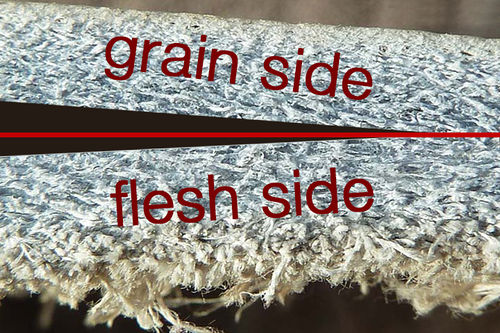
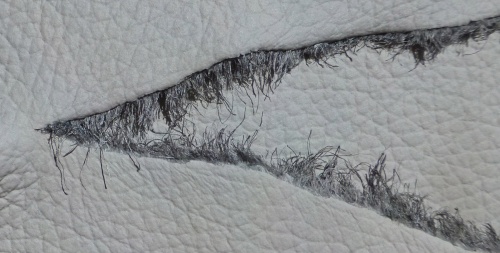
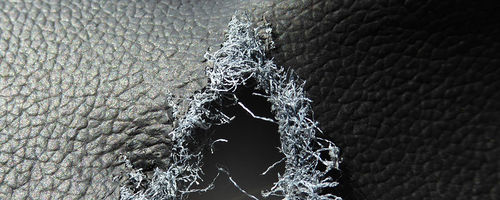
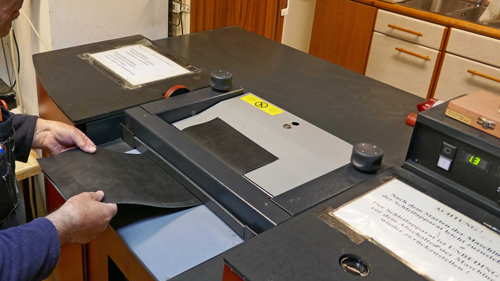
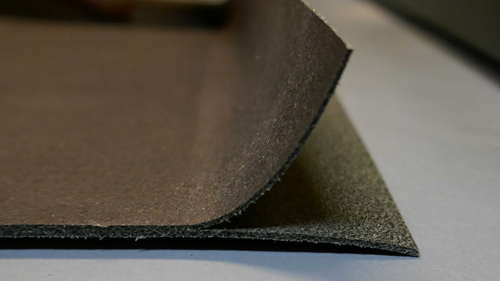
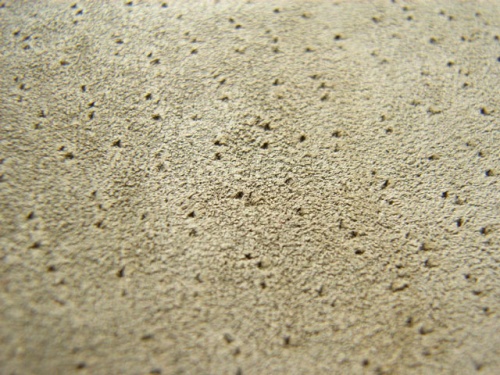
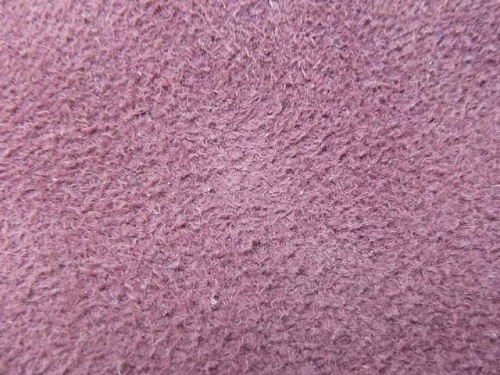
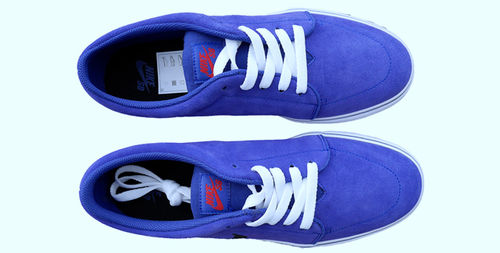

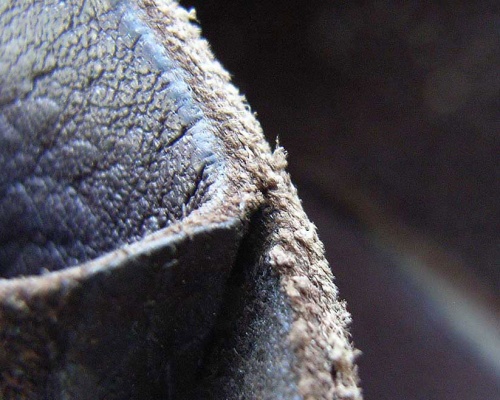
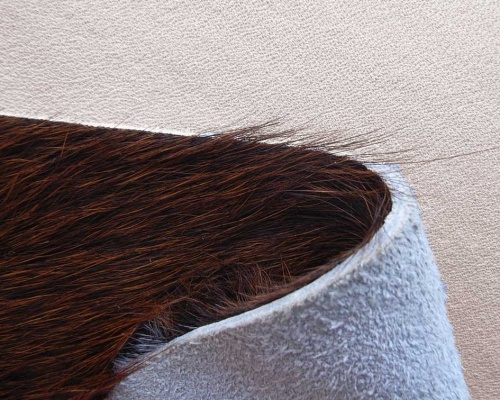
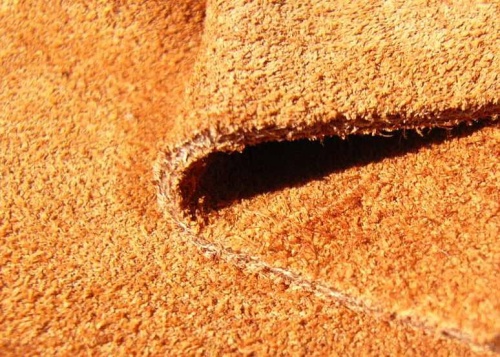
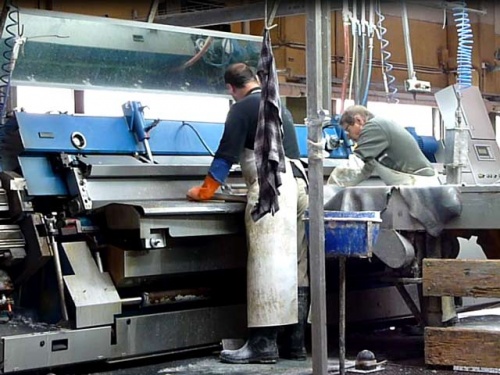
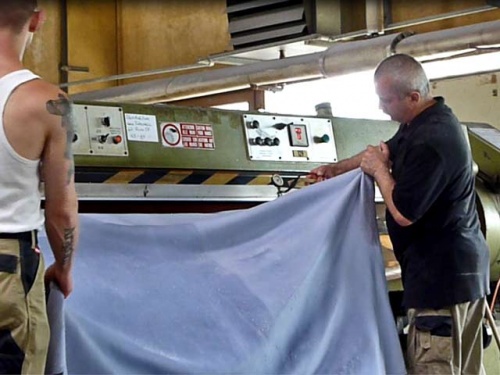
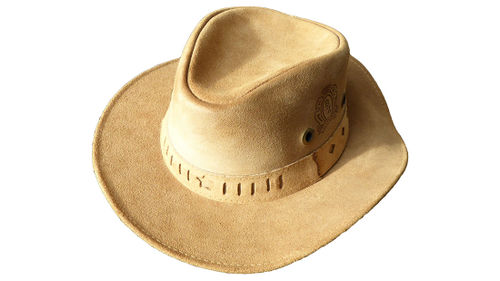
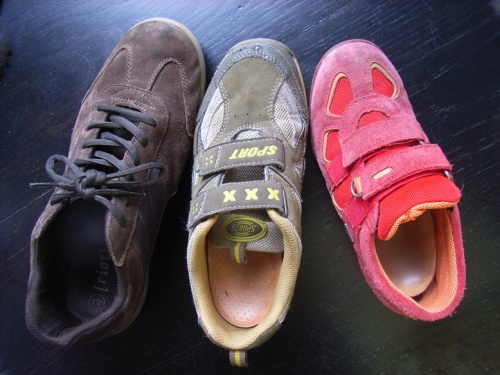
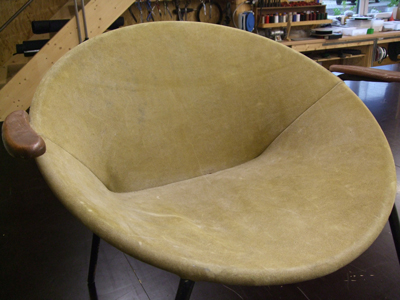
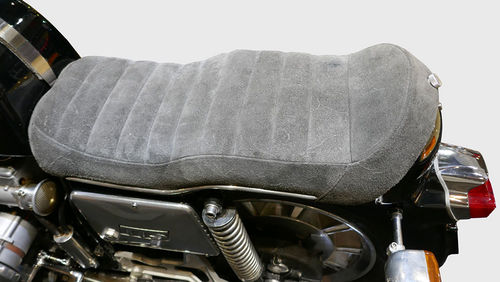
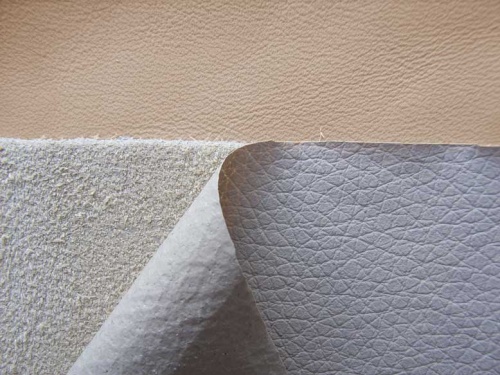
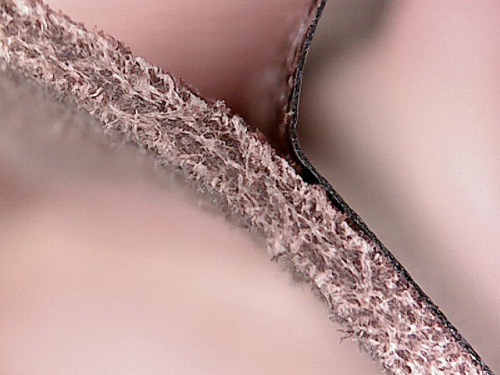
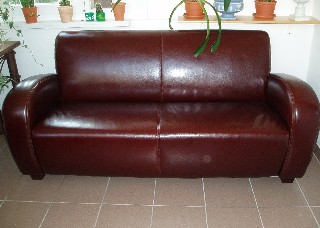
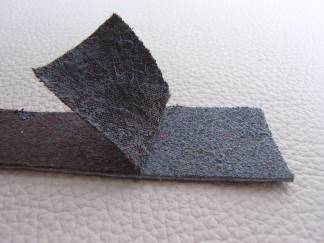
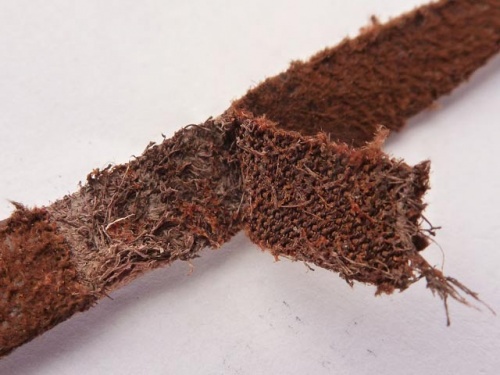
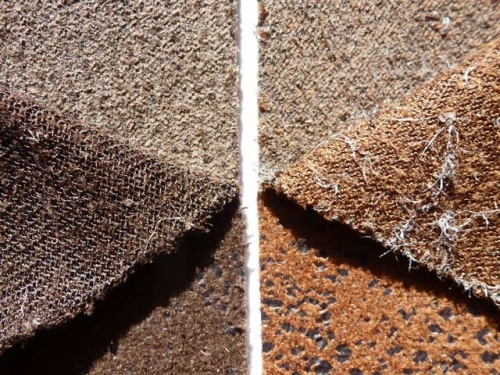
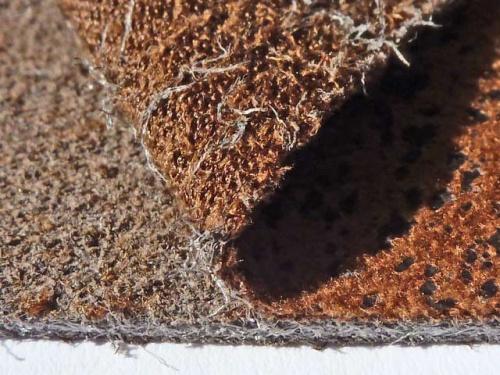
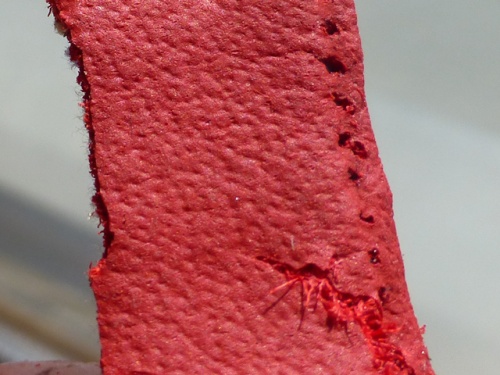
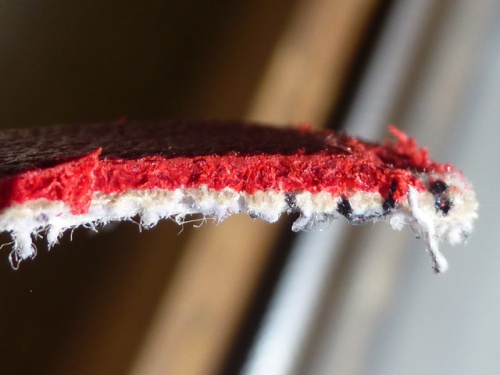
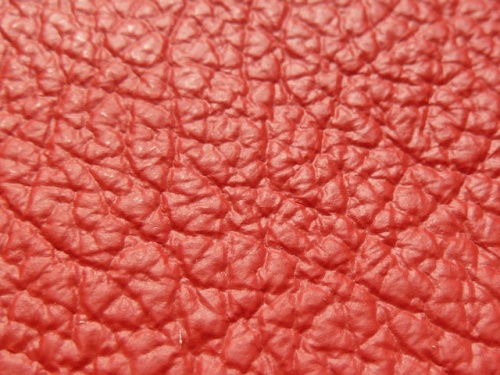
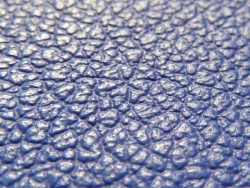
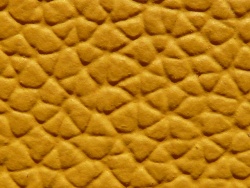
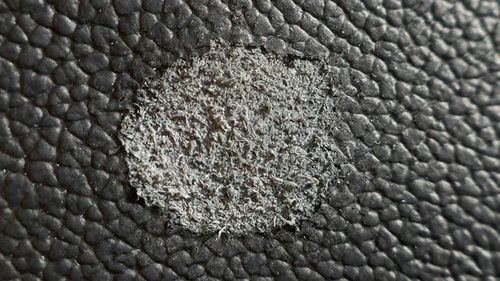
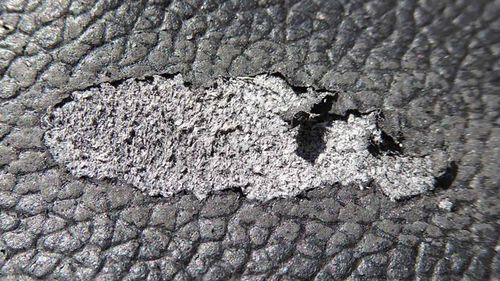
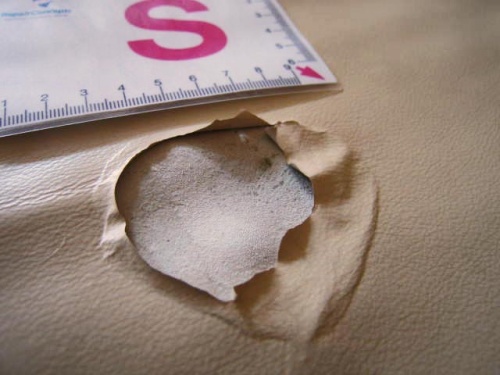
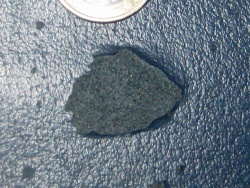
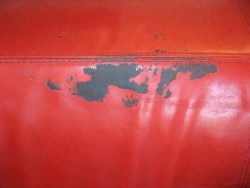
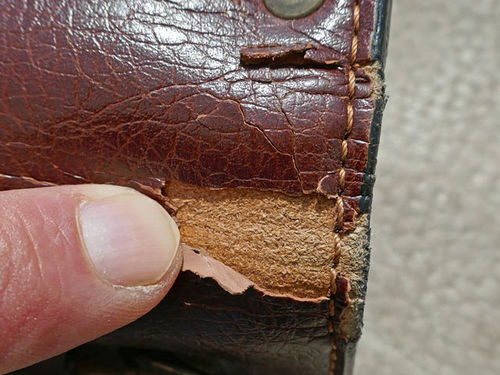
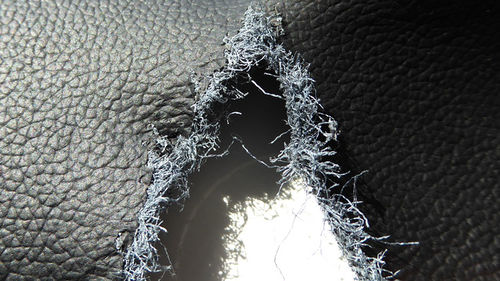
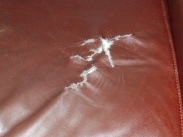
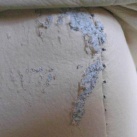
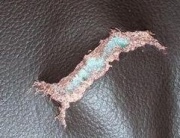
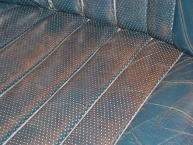
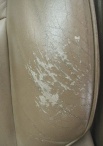
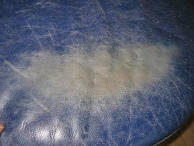

 a kotori web solution
a kotori web solution